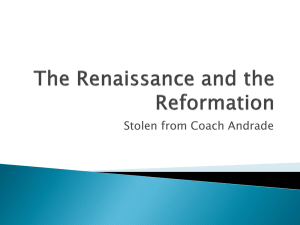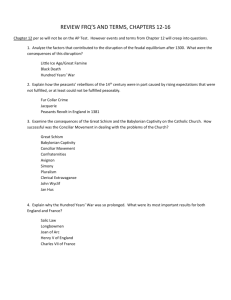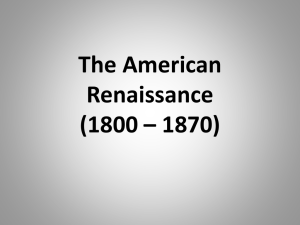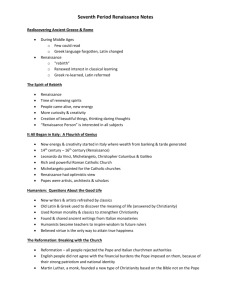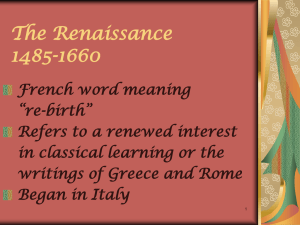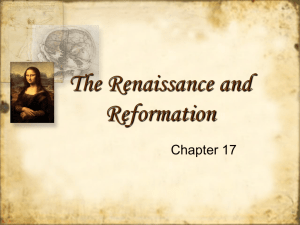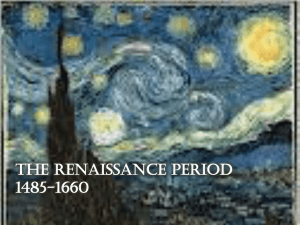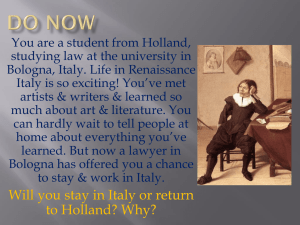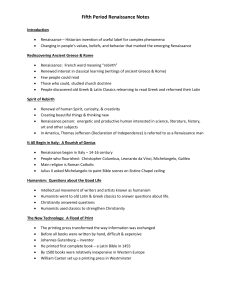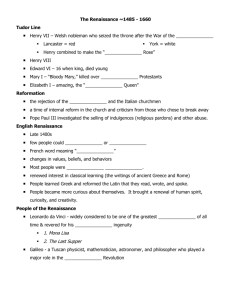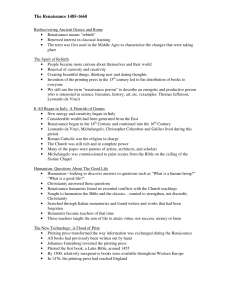Renaissance 1485
advertisement
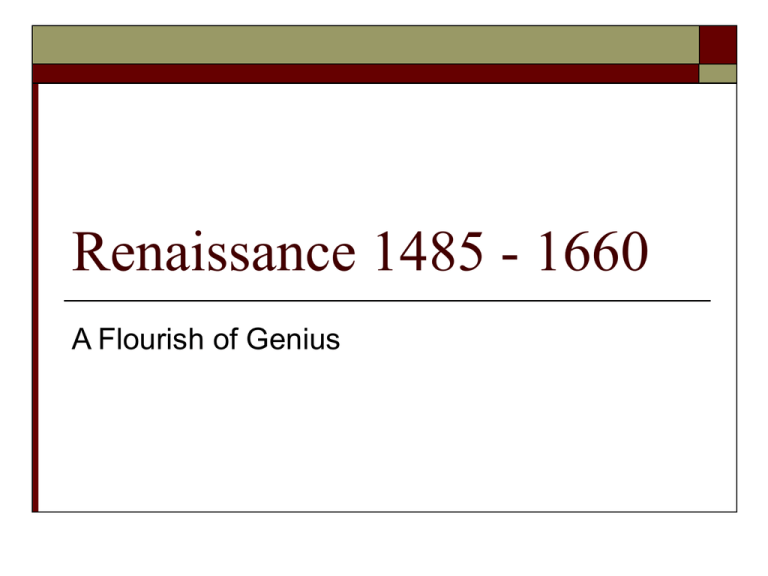
Renaissance 1485 - 1660 A Flourish of Genius When Did it Begin?? There isn’t an exact moment when the Renaissance started. The changes in people’s values, beliefs, and behavior that marked the emerging Renaissance occurred gradually. Why do they call it The Renaissance? The term renaissance is a French word meaning “rebirth.” There was a particular interest in classical learning…especially the writings of ancient Greece and Rome. Greek and Latin classics had been tucked away on shelves for centuries. People learned to read Greek once more and reformed the Latin that they read, wrote, and spoke. The term Renaissance was first used in the 18th century to characterize the changes that began at the end of the Middle Ages and continued through the 16th century. The Spirit of Rebirth People became more curious about themselves and their world than people generally had been in the Middle Ages. There was a renewal of human spirit. The new energy and creativity started in Italy, where considerable wealth had been generated from banking and trade with the East. The Church was very rich and powerful. Almost everyone in Europe was Roman Catholic The Sistine Chapel In your notebooks, what does the “Creation of Adam” say about this artist’s view of humanity during the Renaissance? Humanism Definition: An intellectual movement of the Renaissance that restored the study of the classics and focused on examining human life here and now. “What is a human being?” “What is a good life?” “How do I lead a good life?” Christianity provided answers many Renaissance humanists accepted as true. They sought to harmonize the Bible and the classics to strengthen Christianity. New Technology The invention of the printing press transformed the way information was exchanged during the Renaissance. This dramatically changed education and the availability of literature. Erasmus of Rotterdam and Thomas More Erasmus was a Dutch monk who lived outside the monastery and loved to travel. He visited many countries in Europe. He met Thomas More, who was a young lawyer, while teaching Greek at Cambridge University. The two made great contributions to Renaissance literature, including Thomas More’s Utopia. The Reformation The break from Catholicism and the authority of the pope that resulted in the establishment of the Protestant churches in the 16th century. The force of this movement was felt by all English writers. Martin Luther, a monk, founded a new kind of Christianity. This was based not on what the pope said but on a personal understanding of the Bible. Writers such as More and Erasmus ridiculed old superstitions by calling out the ignorance and idleness of monks and the personal wealth and loose living of priests and bishops. King vs. Pope The conflict between the pope and the king of England came to a climax when Henry VIII wanted to get rid of his wife. His two motives for getting rid of his wife? 1. She had only given him a daughter and was now too old. 2. He wanted to marry Anne Boleyn, who was his mistress. His previous mistress was Anne’s sister. Since divorce was not allowed, he needed a loophole. The pope could not grant Henry’s request because he was controlled by Queen Catherine’s nephew, so Henry appointed a new archbishop of Canterbury. Henry then declared himself the head of English Church. Henry VIII… The first thing Henry did was put Catherine under house arrest. He then closed all of England’s monasteries and sold the rich buildings and lands to his subjects. Sir Thomas More, now lord chancellor, decided to side with the pope. For this he was beheaded. This was the beginning of Protestantism in England. Some groups were angry because it was “not reformed enough.” These were the Puritans, Baptists, Presbyterians, Dissenters, and Nonconformists. They wanted to get rid of “popish things” like church bells, stained glass windows, and bishops. The Tudors Easy to remember…they consist of grandfather, father, and three children. Henry VII was shrewd, patient, and stingy. He restored peace and order to England and lead the cultural Renaissance. The son Henry VIII had six wives. Their fates are summarized in the jingle: Divorced, beheaded, died, Divorced, beheaded, survived. Henry VII ignored his female child, and he died without knowing she would become the greatest ruler England ever had. Elizabeth I: The Virgin Queen One of the most brilliant and successful monarchs in history. She inherited a kingdom torn by fierce religious feuds. She reestablished the Church of England and again rejected the pope’s authority. She survived many plots against her life, several of which were initiated by her cousin (Mary Stuart), who felt that, as a direct descendant of Henry VII, she was the rightful ruler of England. Elizabeth put her in a cell for 20 years, and then killed her. The Spanish Armada Sinks King Phillip of Spain used Mary’s execution to attack England. The fleet he sent was named the Spanish Armada. In 1588, assisted by some nasty weather of the Irish Sea, and Armada was destroyed and Spain is crippled. After this event, Elizabeth becomes the symbol of peace, security, and prosperity to her subjects. She provides inspiration for many English artists.

